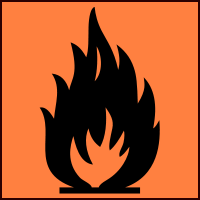Difference Between Flammable and Combustible
 Flammable vs Combustible
Flammable vs Combustible
Generally, people face the dilemma on how to measure and classify these two terms. Yes, it is possible to extort desired facts on the basis of substances that are ‘flammable’ and those are ‘inflammable’.
The heat of combustion of substances is calculated by a method called calorimetry. The concept applied to formulate the heat of combustion is pretty simple. A genuine calorimeter works with the help of a container which contains a substance of recognized properties. The certain material for which the heat of combustion is to be calculated will be burned slowly and in such a manner that the entire heat automatically gets transferred to the substance inside the container. The temperature of the substance inside the container will increase and the heat and the rate of combustion can be calculated easily.
To calculate the flammability of a substance/ material, it has to be passed through the process of fire testing. If we talk about international standards, then there are the numerous test protocols to quantify the degree of flammability. The ratings of the substances/ materials are achieved after fire testing. These ratings are used for preparing the building codes, fire codes, and insurance requirements. Such codes are also important while storing and handling highly inflammable substances. A lot of precautions should be taken while storing such substances inside & outside of building structures. Necessary measures are also taken while carrying such materials on air transportation.
Flammable is a material that can easily catch fire under normal circumstances and with the help of minimal ignition source. Just a spark is sufficient enough. An ideal example of flammable substances is propane.
Combustible materials can include anything that will burn. Propane can also be placed in the same category but more vigorous conditions are required for an ideal combustible material to burn. A simple spark is definitely not enough. Paper or wood can be ideal examples of combustible materials.
In conclusion, we can say that combustion is measured with the help of calorimetry. Flammability is calculated with the help of fire testing. All flammable substances are surely combustible, but all combustible substances are not essentially flammable.
- Difference Between Flammable and Combustible - October 8, 2009
- Difference Between a CEO and a President - October 8, 2009
- Difference Between Ghosts and Spirits - October 8, 2009

you guys have actually made chemistry and other things very easy by your explainations….
While you’ve given a good definition of the words in lay terms, there is a more specific answer. Something is flammable if it will ignite below 100 degrees F (and its pressure is below 40 psi), combustible if it ignites above 100 degrees.
Great achievement
Great progress
Dear
My self Mohammed khaja Moinuddin
Working as Safety officer in India and Gulf Countries with Iosh,osha and Nebosh Igc
Could you please tell the difference between the term Combustible gas and Flammable gas?
I understand that flammable liquid vapor and combustible liquid vapor are different but are they necessarily mean flammable gas and combustible gas respectively?
Thanks a bunch for sharing this with all folks you really recognize what you are
speaking approximately! Bookmarked. Kindly also seek advice from my web site =).
We can have a hyperlink trade arrangement between us